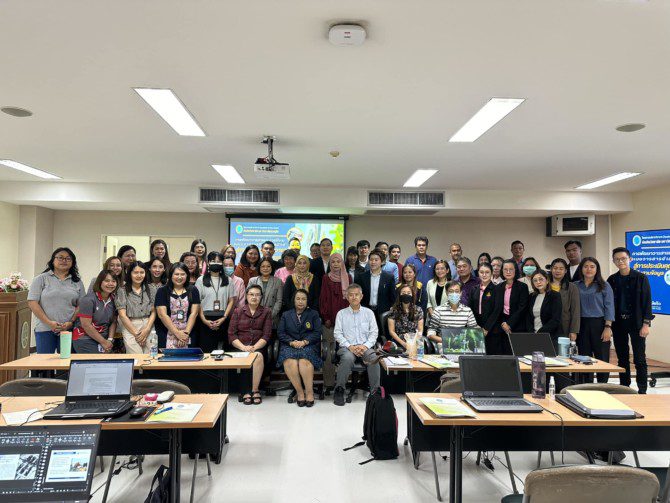
ณภัทร เชาว์นวม. (2565, มกราคม-เมษายน). วรรณกรรมคำสอนเขมร ฉบับเกรกาล สู่ ฉบับเกรกาลใหม่. วารสารวิชาการวิวิธวรรณสาร. 6 (1) : 235-249.
https://so06.tci-thaijo.org/index.php/wiwitwannasan/article/view/255596/172311
บทคัดย่อ
คำว่า ច្បាប់ (จฺบาบ่) หรือ ฉบับ ในทางวรรณกรรมเขมรเป็นหมวดหนึ่งของวรรณกรรมคำสอน ในช่วงพุทธศตวรรษที่ 22-25 ปรากฏวรรณกรรมประเภทฉบับจำนวนหลายเรื่อง โดยปรากฏเรื่อง ฉบับเกฺรกาล และ ฉบับเกฺรกาลใหม่ เป็นวรรณกรรมคำสอนที่ใช้ชื่อเหมือนกัน โดยเพิ่มเติมคำว่า ថ្មី แปลว่า ใหม่ ขึ้นมา บทความวิชาการนี้จึงมุ่งศึกษาวรรณกรรมคำสอนเรื่อง ฉบับเกรกาล และ ฉบับเกรกาลใหม่ โดยมีวัตถุประสงค์เพื่อศึกษาเปรียบเทียบลักษณะร่วมและความสัมพันธ์ของวรรณกรรมทั้งสองเรื่องดังกล่าว ปรากฏผลการศึกษาดังนี้
-
- ผลการศึกษาประวัติและฉันลักษณ์ ได้ข้อสันนิษฐานว่า ฉบับเกรกาลแต่งขึ้นในพุทธศตวรรษที่ 22 โดยไม่ปรากฏผู้แต่ง ส่วนเรื่องฉบับเกรกาลใหม่ มีการระบุปีที่แต่งและผู้แต่ง คือ พ.ศ. 2465 ตรงกับช่วง พุทธศตวรรษที่ 25 โดย พระภิรมย์ภาษาอู หรือ กรมงุย วรรณกรรมคำสอนทั้งสองเรื่องใช้ฉันลักษณ์ประเภทเดียวกันคือบทพรหมคีติ ซึ่งเป็นฉันลักษณ์ที่พบได้ในวรรณกรรมคำสอนบางเรื่องเท่านั้น เมื่อเทียบกับวรรณกรรมคำสอนร่วมสมัยเรื่องอื่น ๆ ที่นิยมใช้บทกากคติเป็นฉันลักษณ์ในบทประพันธ์
-
- ผลการศึกษาการดำเนินเนื้อหา ฉบับเกรกาล ส่วนนำกล่าวถึงวัตถุประสงค์ของการแต่งแต่ไม่ได้ระบุช่วงเวลาการแต่งและไม่ได้ระบุว่าใครคือผู้แต่ง และเริ่มต้นข้อคำสอนด้วยการแนะนำข้อควรปฏิบัติที่เป็นรูปธรรมแล้วจึงแสดงข้อคำสอนต่าง ๆ เนื้อหาส่วนท้ายกล่าวเน้นย้ำให้บุตรหลานจดจำคำสอน ส่วน ฉบับเกรกาลใหม่ เนื้อหาส่วนนำปรากฏวัตถุประสงค์การแต่ง ช่วงเวลาที่แต่งและระบุว่านำต้นเค้ามาจาก ฉบับเกรกาล และเริ่มต้นข้อคำสอนด้วยการกล่าวถึงสิ่งที่เป็นนามธรรม ส่วนท้ายตัวบทผู้แต่งเน้นย้ำให้ลูกหลานจดจำและนำข้อคำสอนไปใช้ ระบุผู้แต่ง จบเนื้อหาด้วยการตั้งจิตอธิษฐานของผู้แต่ง โดยปรากฏแนวคิดหลักของข้อคำสอนสอดคล้องกัน
-
- ผลการศึกษาการใช้คำบ่ง ‘ไม่ให้ทำ’ และ ‘ให้ทำ’ พบว่าปราฏการใช้คำว่า อย่า มากกว่าคำว่า ควร เป็นสิ่งสะท้อนขนบการใช้คำบ่ง ‘ไม่ให้ทำ’ มากกว่า ‘ให้ทำ’ ทว่าเมื่อพิจารณาสัดส่วนการใช้คำบ่งดังกล่าว จาก ฉบับเกรกาล สู่ ฉบับเกรกาลใหม่ ปรากฏใช้คำว่า ควร ในสัดส่วนที่มากขึ้น เป็นสิ่งแสดงถึงพลวัตทางภาษาที่ปรากฏในวรรณกรรมคำสอนทั้งสองเรื่องนี้
ผลการศึกษาแสดงให้เห็นว่าการนำต้นเค้าวรรณกรรมคำสอนที่มีอยู่เดิมมาประพันธ์ใหม่ ในช่วงเวลาที่แตกต่างกัน ผู้แต่งที่เป็นปราชญ์ย่อมพิจารณาในข้อนี้ จึงสร้างสรรค์ผลงานเรื่องใหม่ที่มีรายละเอียดสมบูรณ์ยิ่งขึ้น โดยยังคงไว้ซึ่งลักษณะเด่นตลอดจนแนวคิดหลักของวรรณกรรม
Abstract
The word ច្បាប់ (jbab) or version in Khmer literature was a category of dedactive literature. During the 22nd – 25th Buddhist century, there appeared Jbab Kekal and New Jbab Kekal which was a dedactive literature with the same name by adding the word ថ្មី, meaning new. This academic article focused on the dedactive literature named the Krekal and new Krekal literature. The purpose of this study was to compare the common characteristics and relationships of the two literatures mentioned above. The results of the study were as follows:
-
- The results of the study of history and prosody leaded to the assumption that the Krekal version was written in the 22nd Buddhist century without its author. But in the new Krekal version the year of writing and the author of was stated in 1922 by name ‘Phra Bhirom Bhasa U’ or Krom Ngui. Both didactive literatures used the same type of prosody, Brahma Giti type. which was a prosody that could only be found in some didactive literature. While comparing to other contemporary dedactive literatures where Kakagati type was used.
-
- Results of the study of content Krekal edition. The leading part mentioned the purpose of the composition, but did not specify the composition period and who the author was. It began with the teachings by introduction to concrete practices and then didactive content. The final part inspired decendants to remember the teaching, but in the new Krekal version, the leading part specify the purpose of composition, the time period that was written and identified the source from the Krekal version and began with the didactive content by referring to the abstract. At the end of the text, the author inspired children to remember and apply the teachings and Identified the author. It ended with the content with the author’s prayer. The main concepts of the teachings appeared to be consistent.
-
- The results of the study on the use of the words ‘not to do’ and ‘to do’ was found that the use of the word “don’t” more rather than the word “should” was a reflection of the ‘do not do’ convention more than the ‘to do.’ But considering the proportion of use of the aforementioned words from the Krekal version to the new Krekal version, It appeared that the word ‘should’ was used in larger proportions. It is a representation of the linguistic dynamics presented in these two dedactic literatures.
The results of the study showed that a wise author who considered the rewriting of the original dedactive literature at different times, would be able to create new works with more complete details by maintaining the distinctive characteristics and main ideas of literature.










ความคิดเห็น